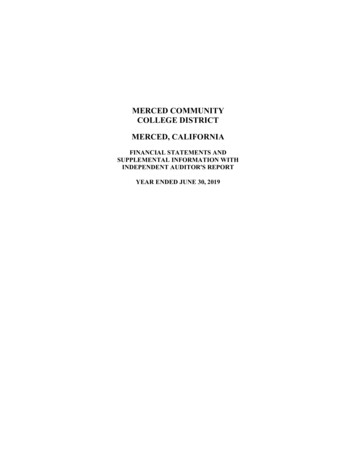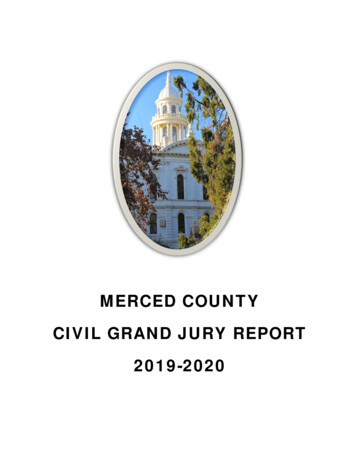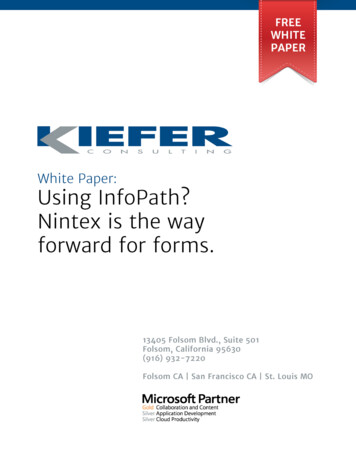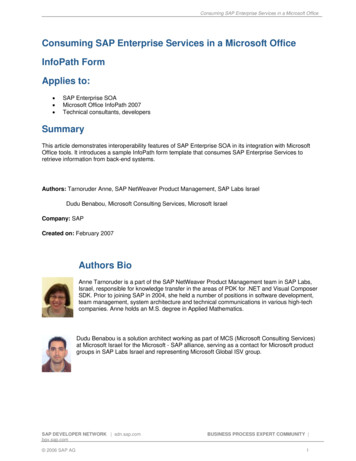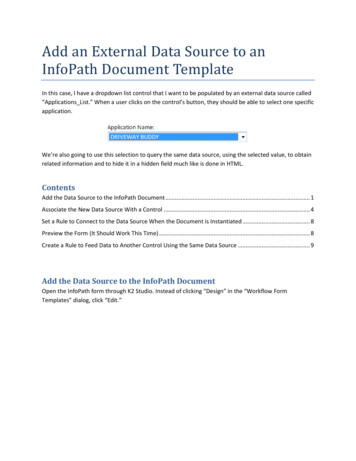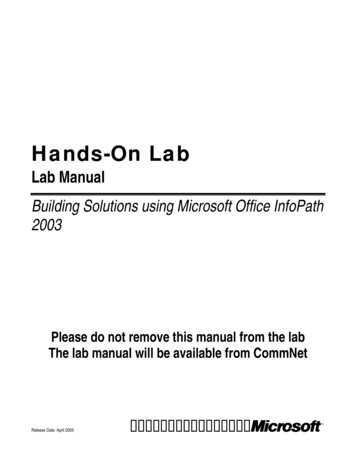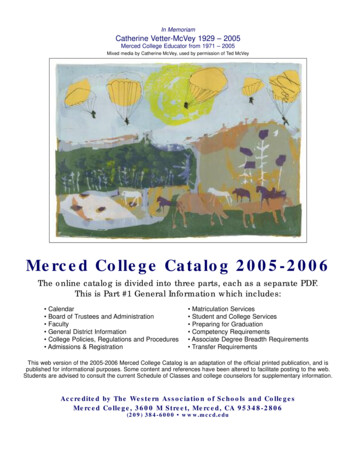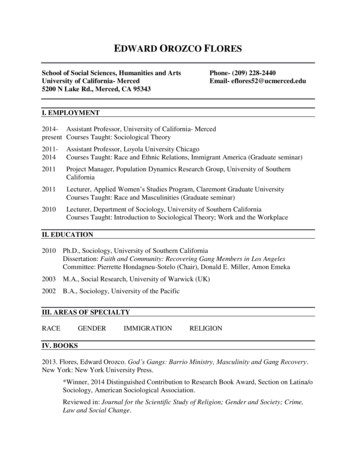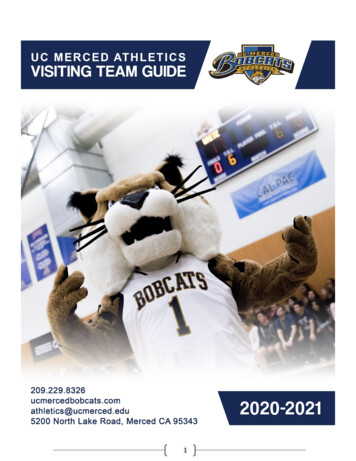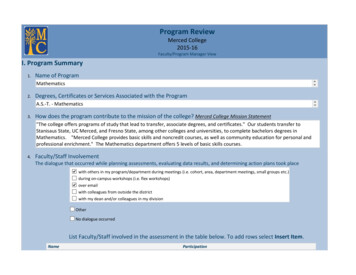
Transcription
Program ReviewMerced College2015 16Faculty/Program Manager ViewI. Program Summary1.Name of ProgramMathematics2.Degrees, Certificates or Services Associated with the ProgramA.S. T. Mathematics3.How does the program contribute to the mission of the college? Merced College Mission Statement"The college offers programs of study that lead to transfer, associate degrees, and certificates." Our students transfer toStanisaus State, UC Merced, and Fresno State, among other colleges and universities, to complete bachelors degrees inMathematics. "Merced College provides basic skills and noncredit courses, as well as community education for personal andprofessional enrichment." The Mathematics department offers 5 levels of basic skills courses.4.Faculty/Staff InvolvementThe dialogue that occurred while planning assessments, evaluating data results, and determining action plans took place with others in my program/department during meetings (i.e. cohort, area, department meetings, small groups etc.)during on campus workshops (i.e. flex workshops)over emailwith colleagues from outside the districtwith my dean and/or colleagues in my divisionOtherNo dialogue occurredList Faculty/Staff involved in the assessment in the table below. To add rows select Insert Item.NameParticipation
Patrick Mitchell Program Review AuthorDiscussion ParticipantData ContributorJulie KehoeProgram Review AuthorDiscussion ParticipantData Contributor John Montoya Program Review AuthorDiscussion ParticipantData Contributor Program Review AuthorDiscussion ParticipantData Contributor Program Review AuthorDiscussion ParticipantData Contributor Program Review AuthorDiscussion ParticipantData ContributorSteve MeidingerJulie ClarkKristi RiegII. Assessment Summary4.Please provide a status update of all course SLO assessments.List the dates of the last two assessment reports, starting with the most recent. (Dates must be within the last five years.)
Course NumberPrevious AssessmentNext Planned AssessmentContact FacultyMath 06Spring 2014Spring 2016Julie KehoeMATH 07Spring 2015Spring 2017Kathy KanemotoMATH 04BSpring 2015Spring 2017Patrick MitchellMATH 02/02H2011 12Fall 2016Mai MeidingerMATH 04C2011 12Fall 2016Greg HoganMATH 20A2013 14Fall 2016Kristi RiegMATH 902012 13Fall 2016Jim BryanMATH 912012 13Fall 2016Steve BellMATH B2011 12Fall 2016Steve BellMATH 082013 14Spring 2017Ivan NavarroMATH 152013 14Spring 2017Julie ClarkMATH 20B2013 14Spring 2017John MontoyaMATH 802013 14Spring 2017Lisa DiazMATH 852014 15Spring 2017Steve Meidinger5.Means of AssessmentList the program SLO/SAO in the space below.Program SLO or SAOA. Use Calculus techniques to solve mathematical problems involving functions of one or more variables.Links to Institutional Learning Outcomes CommunicationComputationCognitionGlobal and Community Consciousness and ResponsibilityPersonal Development and Life Long LearningSelect means of assessment, or select Other and type in the means of assessment.
Assessment results of course SLOs linked to each program SLOItem analysis of exams, quizzes, problem sets, etc. (items linked to specific outcomes)Assignments based on rubrics (essays/reports, projects, performances, presentations, etc.)Assignments based on checklistsClassroom Assessment Techniques (CATS, “clicker” mediated responses, etc.)Direct observation of performances, structured practice or drills, “practical” exams, small group work, etc.Capstone projects or final summative assessment (final exams, capstone projects, portfolios, etc.)Direct assessment of service activitiesOtherBenchmark MetProgram SLO or SAOB. Demonstrate appropriate techniques to solve mathematical problems.Links to Institutional Learning OutcomesCommunicationComputationCognitionGlobal and Community Consciousness and ResponsibilityPersonal Development and Life Long Learning Select means of assessment, or select Other and type in the means of assessment. Assessment results of course SLOs linked to each program SLOItem analysis of exams, quizzes, problem sets, etc. (items linked to specific outcomes)Assignments based on rubrics (essays/reports, projects, performances, presentations, etc.)Assignments based on checklistsClassroom Assessment Techniques (CATS, “clicker” mediated responses, etc.)Direct observation of performances, structured practice or drills, “practical” exams, small group work, etc.Capstone projects or final summative assessment (final exams, capstone projects, portfolios, etc.)Direct assessment of service activitiesOther
Benchmark MetProgram SLO or SAOC. Apply mathematical models to real world problems.Links to Institutional Learning Outcomes CommunicationComputationCognitionGlobal and Community Consciousness and ResponsibilityPersonal Development and Life Long LearningSelect means of assessment, or select Other and type in the means of assessment. Assessment results of course SLOs linked to each program SLOItem analysis of exams, quizzes, problem sets, etc. (items linked to specific outcomes)Assignments based on rubrics (essays/reports, projects, performances, presentations, etc.)Assignments based on checklistsClassroom Assessment Techniques (CATS, “clicker” mediated responses, etc.)Direct observation of performances, structured practice or drills, “practical” exams, small group work, etc.Capstone projects or final summative assessment (final exams, capstone projects, portfolios, etc.)Direct assessment of service activitiesOtherBenchmark MetProgram SLO or SAOD. Use technology to support mathematical problem solving.Links to Institutional Learning Outcomes
CommunicationComputationCognitionGlobal and Community Consciousness and ResponsibilityPersonal Development and Life Long Learning Select means of assessment, or select Other and type in the means of assessment. Assessment results of course SLOs linked to each program SLOItem analysis of exams, quizzes, problem sets, etc. (items linked to specific outcomes)Assignments based on rubrics (essays/reports, projects, performances, presentations, etc.)Assignments based on checklistsClassroom Assessment Techniques (CATS, “clicker” mediated responses, etc.)Direct observation of performances, structured practice or drills, “practical” exams, small group work, etc.Capstone projects or final summative assessment (final exams, capstone projects, portfolios, etc.)Direct assessment of service activitiesOtherBenchmark Met6.Assessment Data and Results for each PLO/SAO7.Analysis and Interpretation of Results for each PLO/SAO (include benchmarks)8.Do your program outcomes represent learning appropriate to the standards of your discipline or profession? (Thismay not apply to all service areas.)
9.Plans for ImprovementProgram Review Data:To view the relevant data for the following questions select the link below, log into the MC4MePortal, then choose your area.Instructional Program Review Data10. What trends, if any did you identify ina. student demographics for your program compared to the district?Our students are younger than the District average. We also have more Hispanic students and fewer white, non Hispanicstudents.b. instructional demographics for your program compared to the district?Our CCR and CSR are virtually unchanged from last year and are lower than the District average (success rates in Math willlikely always be below the District average this statistic is not meaningful). Productivity and WSCH increased from lastyear. Our % of classes filled and average section size continues to exceed the District average.11. Are there any factors influencing the student access to services/programs?We often have difficulty staffing courses. Additional full time faculty, and better pay for part time faculty, would help with thisissue.III. Planning SummaryRemember to attach your goals sheet(s) in the Attachments section below. Please click here: An example of a template for an example of a template to use forrecording your program goals.Planning Goals for 15 16 PR.docxMicrosoft Word Document20.3 KB
Or for the LRC, AV, or ITS click on the link below to add your goals:12.Have there been any internal/external changes to this program/department which have had a significant impact onthe program's goals and/or effectiveness? If so, please explain.Professor Travis McDonald resigned at the end of the 2014 15 school year, and Professor Tina Akers Porter left for a one yearunpaid leave of absence. Professor Ivan Navarro was hired to replace Jim Retemeyer (who had left at the end of 2013 14), andProf. Maria Albert was hired to replace Prof. McDonald. Prof. Lisa Diaz was hired on a one year temporary contract to fill in forProf. Akers Porter.Resource AllocationzComplete the table for each resource request. Please rank in order of priority according to your program assessmentresults.ResourceLearning Outcomes Reason for ResourceSelect all that applyAdditional full timefaculty forMathematicsOutcomes/GoalsGoal 1Institutional SLOsCommunicationComputationCognitionGlobal ConsciousnessPersonal Development Additional officespace forMathematicsSelect all that applyOutcomes/GoalsGoal 1 Institutional SLOsCommunicationComputationCognition SafetyComplianceMaintain ProgramGrow ProgramCommentsA replacement position is needed for Brandon Leonard, and atleast one new position is needed to attain the goal of a 75/25full time to part time ratio. The Mathematics Department hasnot been granted a new position since 2010; only replacementpositions.Office space in the Science Building is currently exhausted. Ournewest full time hires, Christiane Touma and Raj Mohan, aresharing a conference room as an office. Part time faculty areusing an unused Division Secretary office on the secondfloor. Last year, one of the Math faculty had an office in theCommunications Building because there was no room for her in
Global ConsciousnessPersonal Development the Science Building. Students of part time faculty, and someSafetyfull time faculty, do not have equitable access to theirComplianceMaintain Program instructors.Grow Program SafetyComplianceMaintain ProgramGrow ProgramStudents in Los Banos are still without a Math Lab. CSR andCRR for Mathematics courses in LB continue to lag behind themain campus. Statistics have shown for years that studentswho use the Math Lab on the main campus perform better thantheir peers who do not. SafetyComplianceMaintain ProgramGrow ProgramMathematics faculty would like to be able to attendconferences, to learn about new ways to use technology,become trained in instructing students who have beeneducated in Common Core, etc.Outcomes/Goals Los Banos Math LabGoal 3Institutional SLOsCommunicationComputationCognitionGlobal ConsciousnessPersonal Development Outcomes/GoalsProfessionaldevelopment money Goal 4 Institutional SLOsCommunicationComputationCognitionGlobal ConsciousnessPersonal DevelopmentOutcomes/Goals
Additional staffingfor Merced MathLabGoal 3 Institutional SLOsCommunicationComputationCognitionGlobal ConsciousnessPersonal DevelopmentSafetyComplianceMaintain ProgramGrow ProgramOutcomes/Goals Computer upgradesSome computers in faculty offices, classrooms, and the MathSafetyLab are old and need to be replaced.ComplianceMaintain ProgramGrow ProgramGoal 2Institutional SLOsCommunicationComputationCognitionGlobal ConsciousnessPersonal Development Outcomes/GoalsSmartboardGoal 2 Institutional SLOsCommunicationComputationCognitionGlobal ConsciousnessPersonal DevelopmentOutcomes/GoalsDuring peak times in the Math Lab, students have to wait to gethelp from an instructor. We should identify the busiest times,and have two faculty working the lab during these times. Wewould also like to see the return of paid Peer Tutors we hadone (Abraham Cisneros) in Fall 2015, but not since. SafetyComplianceMaintain ProgramGrow ProgramAt least one Math classroom should be equipped with aSmartboard. MATH 04C and other appropriate classes could betaught in this room. Students in MATH 04C study the graphs of3 dimensional objects which are difficult to draw and visualize.
Color printerGoal 2 Institutional SLOsCommunicationComputationCognitionGlobal ConsciousnessPersonal Development New printer forback hallwayThe Mathematics faculty would find it helpful to have access toSafetya color printer upstairs.ComplianceMaintain ProgramGrow ProgramOutcomes/Goals Goal 2 Institutional SLOsCommunicationComputationCognitionGlobal ConsciousnessPersonal Development The laser printer on the 2nd floor west hallway is old and in badSafetyshape and needs to be replaced.ComplianceMaintain ProgramGrow Program13.Were any of your resource allocation requests fulfilled in the last year? YES NO N/Az If yes, explain why the item was needed, how it affected student success and how you measured studentsuccess related to the requested resource.14.How is your program leveraging other resources?The HSI STEM grant had provided funding for SI leaders in all MATH 04A sections, and some reassigned time for faculty to work asHSI STEM advisors, but this grant has now run out and we are not currently providing SI leaders in Calculus sections.
15.List any resources your students would benefit from having in the LRC. (i.e. books, journals, media, etc.)Insert any resources the LRC can provide.IV. Additional Information16.Is there anything else you would like to be considered in the annual planning document?It appears that curriculum changes that were made to MATH 25 and MATH 02 led to significant improvements in CCR and CSR inthose courses, and slight improvements in MATH 04A (the course following MATH 02).AttachmentsPlease attach any relevant documents to the program review.Include items like, current outcomes mapping, rubrics, assessment data, and the previous assessment, if possible.To attach multiple files select Insert Item.PSLO Mapping.xlsxMicrosoft Excel Worksheet29.6 KBV. Document EvaluationSelf Evaluation of Program ReviewPlease perform a self evaluation of the completed annual program review using the criteria for proficiency below. Thepurpose of the self evaluation is to improve the quality of program review reports.
Criteria for Proficiency in Program Outcomes AssessmentReviewers: Select the score from the columns that best reflects the content of the report being reviewed1. Means of AssessmentSelect.2. Assessment Data and ResultsSelect.3. Analysis and Interpretation of ResultsSelect.4. Plans for ImprovementSelect.Process EvaluationPlease provide feedback to the Office of Institutional Effectiveness regarding the assessment process:1. What changes to the review process or template would make program assessment more meaningful or useful to you?It seemed arduous for an annual review. Some of the data will be redundant to report from year to year (e.g., the SLO assessmentschedule).2. What difficulties (if any) did you experience in completing the program review?I don't know how to go out and look for all the SLO assessment results that map into our PLOs, and I don't have the time to figure it out. Ihave already spent approximately ten hours working on this. I understand that the old annual program review took about three hours tocomplete.
3. What resources (if any) would make the review easier to complete?Clerical assistance to retrieve data like SLO assessment results.4. Do you have further comments or suggestions?Faculty need to be compensated for completing program reviews in this new template. It is much more involved since comprehensiveprogram reviews went away.Once complete, submit by choosing one of the options below:For All other programs:Select your COHORT from the list below:Math/Engineering/Computer Science/AccountingMAKE SURE TO SAVE YOUR COMPLETED FORM BEFORE SUBMITTING FOR REVIEW:
6. Assessment Data and Results for each PLO/SAO 7. Analysis and Interpretation of Results for each PLO/SAO (include benchmarks) 8. Do your program outcomes represent learning appropriate to the standards of your discipline or profession?
